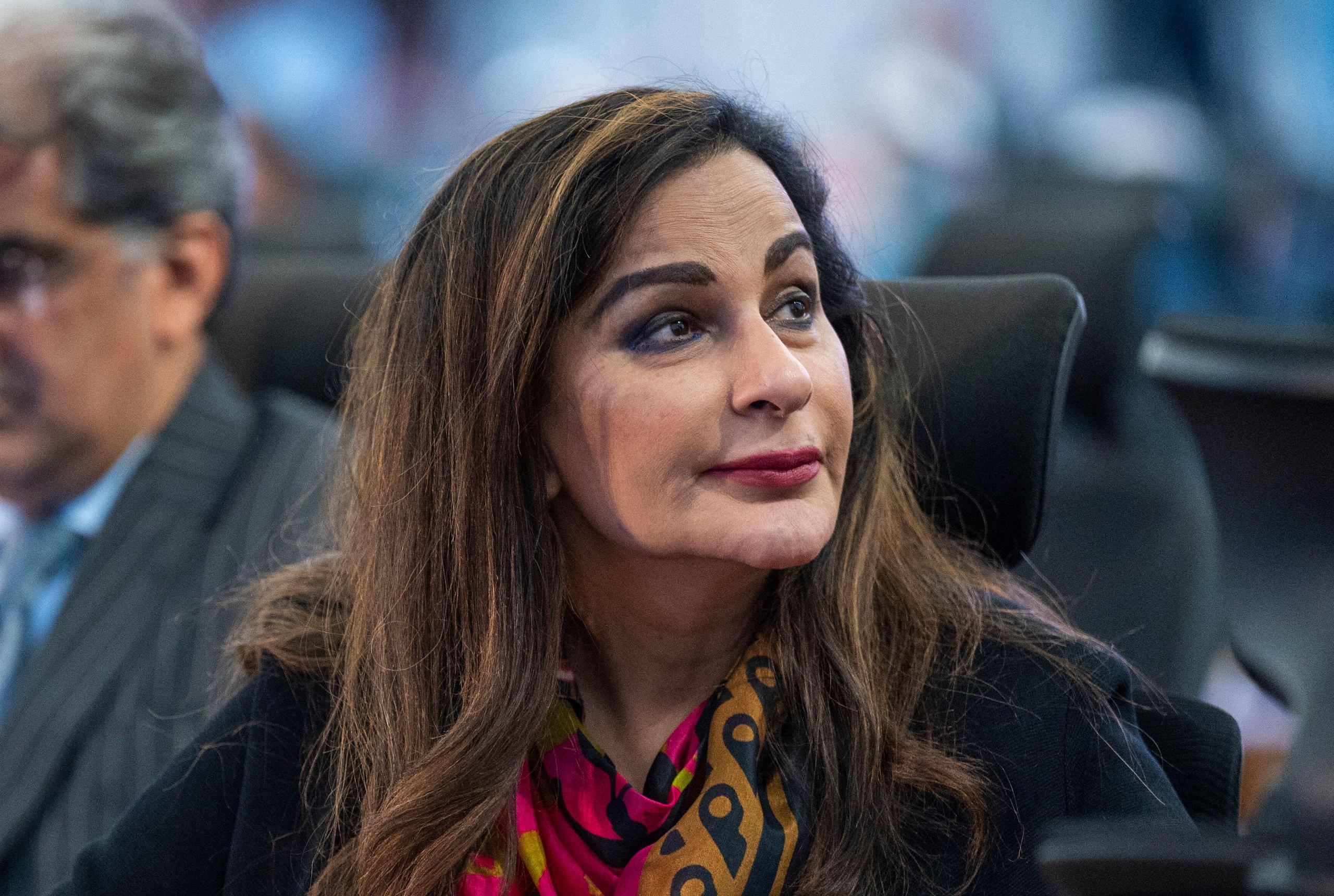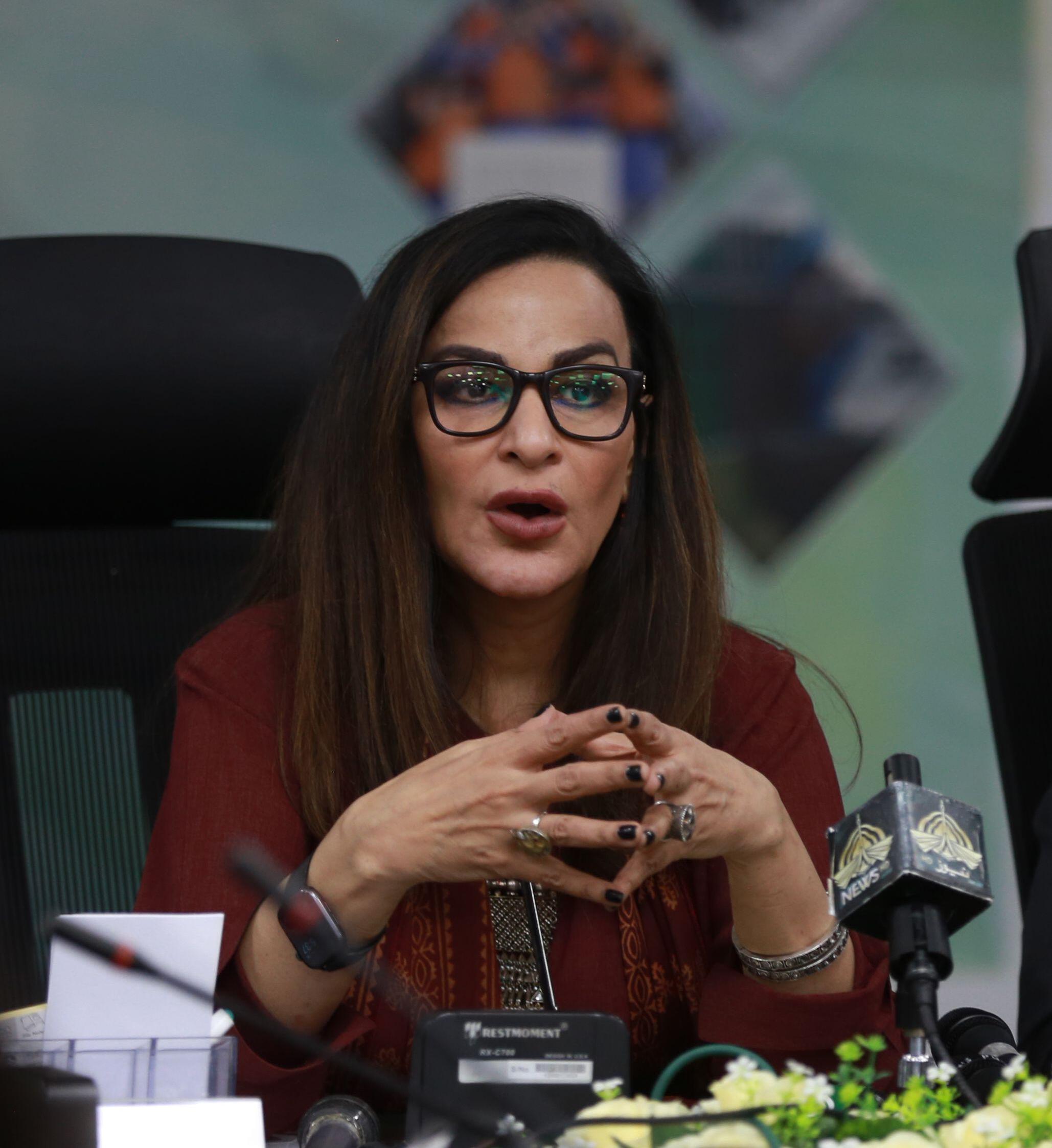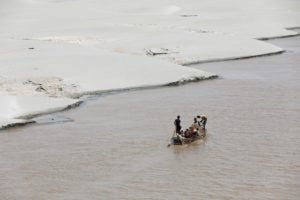
Sherry Rehman, then Pakistan’s federal minister for climate change, at climate summit COP27 in Sharm el-Sheikh, Egypt, November 2022 (Image: Christophe Gateau / Alamy)
During her 17 months as the federal minister for climate change and environmental coordination in Pakistan, Sherry Rehman oversaw several ambitious projects aimed at increasing the country’s resilience to climate change. Her tenure, which ran from April 2022 until August 2023, coincided with climate summit COP27 at which, as a member of the G77 and China bloc, Rehman lobbied for the establishment of an international loss and damage fund.
It was also during Rehman’s incumbency that Pakistan faced one of the deadliest floods in its history, bringing the country’s vulnerability to the effects of climate change to the fore. Now with an interim caretaker government holding the reins of power until the next elected government takes over, Pakistan’s ability to steer ambitious climate resilience projects is being eyed cautiously by experts. Here, Sherry Rehman shares her thoughts on what comes next for Pakistan as it faces a future of climate uncertainty.
The Third Pole: Pakistan seems to be in the grip of consecutive crises – is the country ready to meet the challenges of climate change?
Sherry Rehman: Climate change has been one of the most under-resourced and under-powered issues in Pakistan, even though the country has become a poster child for cross-sectoral climate, pollution and environmental vulnerabilities. Pakistan is going through a climate polycrisis, so there is no one issue and no silver bullet that will fix things overnight.
However, we all know that Pakistan faces a challenging decade of climate stressors in more ways than one. Given the level of impacts we are facing due to global warming, building resilience is going to be a priority for our growing population. Adaptation needs to be taken out of its stepchild slot both in Pakistan, and in global policy-making. It needs active financing and capacity resourcing as a national emergency if the country is to survive growing heat and related shocks.
The Third Pole: What is an example of a pressing environmental issue that you feel is not being taken seriously enough?
Sherry Rehman: Pakistan’s frontline crises are in the water and food space. Water is critical to Pakistan’s human, social and national security. It is completely underplayed in my view, given the state of dependence on one basin, which is the Indus River system. Climate solutions, particularly at the federal level, are too fragmented and under-leveraged to make the transformational shift that is needed.
Firstly, the Water Resources Ministry needs to actually start implementing its Water Policy and modernise its capacity, outreach and coordination for doing far more than prioritising long-gestation infrastructure projects. Viable rain harvesting projects need to be launched in each province and canal leakage plugged in Punjab and Sindh. Flood adaptation and wetland recharge requires a number of coordinated, community-based solutions. Many such action menus based on local solutions, including community ponds, are available in the Living Indus Initiative project.
Secondly, the Planning Ministry for its part needs to embed water adaptation into the framework it uses for development and resource allocation, and move past colonial-era infrastructure as the only road to storing water or preventing flooding.
Nature-based solutions must be applied wherever they can
Thirdly, the Food Security Ministry needs to upscale its climate-smart agriculture solutions and build resilience tools for irrigating crops in the provinces by sharing capacity and local solutions. Agriculture is the largest consumer of water in Pakistan, particularly thirsty crops like rice and sugarcane. Sustainable irrigation models need to be promoted, not just pilot projects but those that can be upscaled, while drought-resilient seeds and new crops have to be introduced in farms across the Indus Delta region, which is fast depleting its ground water as well as its local economy.
Promoting intensive or subsidised solar tube-well usage is also not helping the water-deficit balance, because much of the ground water has dried up and transformed into a finite resource due to excessive usage and no cyclical recharge. Over-use of tube-wells is depleting all aquifers, while unchecked population growth is multiplying stresses on available water resources in the Indus Basin. Sindh has no sweet water left in its aquifers, while Punjab is running out fast.

Fourth, the provinces need to take stock, create policy frameworks, and start legally enforcing flood zoning, water conservation and municipal management. Sindh has created its own water policy in 2023, but for its growing urban areas it has to connect the complex dots of improving water governance in a landscape of competing and uncoordinated municipal and land-use agencies. Big investments in the water, sanitation and health sectors can help manage urban flooding impacts, which is the one area international assistance can be made available. Wastewater treatment and desalination interventions imply capital outlays, but can be outsourced by cities in public-private partnership investment models. Different solutions will apply to mountain areas and the crisis-ridden delta areas. These, including tech-based solutions, are identified and curated in the National Adaptation Plan.
Fifth, nature-based solutions must be applied wherever they can. Mangrove ecosystems and wetland recharge projects can build nature-based buffers to flooding. Where greening budgets are slashed, the provinces can monetise existing carbon sinks, like Sindh has done to replenish and add to its mangrove cover. Whether mountain forests or delta mangroves, some percentage of trading in carbon markets can generate the liquidity to replace forest cover. The good news is that Recharge Pakistan has found itself a climate grant of USD 77 million, but once it is spread out over the provinces into one project each, the scale will not be enough for full-basin upgradation.
Pakistan needs its citizens to save water
Each province and federal territory has forests it needs to save, and leverage for climate solutions, emission reductions and water management. Across the country, flood and water management interventions reinforce each other. No hotels on riverbanks; no highways across green areas; because the environment does not degrade in silos. When biodiversity losses hit a danger zone, they take wetlands and rivers down.
Lastly, while still in the big-picture mode, Pakistan needs its citizens to save water. Per capita usage in the country is entirely unsustainable, as it stands. Under a high-warming and high population growth scenario, water demand is projected to increase by almost 60%, especially in the domestic and industrial sectors. Currently, we have one of the highest levels of per capita water usage in the world. According to the IMF, Pakistan’s per capita annual water availability as of 2017 was 1,017 cubic metres, perilously close to the scarcity threshold of 1,000 cubic metres. In 2023, many urban areas report dangerous deficits which are compounded by the murky politics of informally priced distribution.
The Third Pole: Which projects that you initiated or worked on are particularly proud of? Where do you see them going?
Sherry Rehman: The Ministry of Climate Change’s National Adaptation Plan (NAP) is a crucial, medium-term pathway for mitigating the impacts of climate change on Pakistan’s most vulnerable sectors.
The plan’s identification of eight such sectors is a significant milestone, as it enables the creation of a comprehensive mitigation strategy. Those eight sectors include agriculture, water resources, health, disaster preparedness, biodiversity, and urban resilience. The plan’s focus on these sectors – if followed by the executing provinces – will prioritise the allocation of resources toward areas that require urgent attention. For example, disaster preparedness, planning and social safety nets.
The National Adaptation Plan is designed to be sensitive to the growing needs of the rural and urban poor (especially women and children), the youth cohorts who are key to behaviour change, and urban communities facing the new challenge of involuntary migrations. The mountain-to-delta plan for adaptation also prioritises agriculture because growing food, managing rangelands, and livestock livelihoods are fundamental to Pakistan’s current economic structure. The context, both globally and nationally, should no longer be defined as anything but a crisis of widespread hunger. The 2023 Hunger Hotspots report by the UN Food and Agriculture Organization and World Food Programme lists Pakistan as a country of “very high concern” along with Kenya, Congo, Ethiopia, Central African Republic, and Syria. There is a long list of actions to take, including the strengthening of water and food governance in Pakistan. Strengthening the shock-responsive capacity of existing social protection programs like the Benazir Income Support Programme is key.
My cautionary note is to not lose momentum on work already started
Sherry Rehman
At the same time, the level of recurring climate emergencies calls for building the capacity of national and provincial disaster management authorities, because in the last climate disaster in 2022, Pakistan had well over 10 million people exposed to acute food insecurity. The crisis is cross-sectoral, as the NAP says. That is the only way to address it, not in policy and departmental silos.
Air pollution too is a leading environmental hazard and a killer of 128,000 people annually in Pakistan, even according to conservative estimates in recent years. Ours is a country with low emissions on a global scale, yet our urban air pollution levels are too high. The National Clean Air Policy offers low-infrastructure investments that can be made immediately by the provinces.
Elsewhere, we have pushed very hard to develop the Living Indus Initiative. The Indus Basin is under stress from overcrowding, pollution and climate change; the river services 80-90% of our population, yet is one of the world’s most polluted. Each province – including Gilgit-Baltistan and Pakistan-administered Kashmir – has a stake in its restoration.
If followed, even incrementally, the Living Indus Initiative would repair and restore the basin’s natural resources and ecosystems. It proposes a menu of 25 interventions to initiate coordinated, executive restoration efforts. What the initiative seeks to do would be transformational, but only if it is embedded into all development projects to secure necessary financing.
Now, all these projects require inter-ministerial focus, as well as sub-natoinal action by the provinces.
The Third Pole: What challenges will your successor face?
Sherry Rehman: My first cautionary note is to not lose momentum on work already started. If that momentum is squandered, the country’s regional needs will start changing faster than our national ability to execute policies. Climate change is real, it is accelerating across the board, and it needs high-level energy and focus. Without this momentum, even our international partners – who are extremely committed to supporting us – will lose purpose.
Second, the issues, not just the ministry, needs the constant elevation of multiple climate, environmental and pollution agendas. Given the large, intensifying terrain of environmental, climate and pollution responses needed in Pakistan, many of which compete for capacity and resources, the identification of priorities for both government and international spaces, the development and public sector or multilateral and bilateral partners is not a new problem, but a growing one. The task of moving communities, public and business sectors in any timelined roadmap for resilience and reduction in emissions will need critical mass, regular stocktakes and more thought leadership and critical inquiry.
Third, build on acquiring serious technical capacity, because there is a deficit in the public sector. It is not a ministry for just raising climate funds, it is so much more, because so much more is needed.
The Third Pole: Do you see carbon trading as a realistic opportunity for Pakistan?
Sherry Rehman: Absolutely! This has already begun, with Sindh taking a lead in monetising its carbon sequestration and ploughing investments back into regrowing its mangroves, which absorb four times as much carbon as any other forest. The Sindh government’s Delta Blue Carbon Project, aimed at restoring 350,000 hectares of mangroves, is a pioneering step towards voluntary carbon markets. Mitigation capacity could also be potentially increased with the restoration of the mangrove forests: 27 million tonnes of CO2-equivalent emissions could be reduced over the life cycle of this project.
Carbon trade resources could also help us to establish climate-smart agriculture opportunities for small-scale farmers. Green jobs should continue to prioritise indigenous women, as training affords them both incomes and sustainable connections with conserving natural capital.
Climate finance, and especially carbon trading, is new and unfamiliar territory for many developing countries, but the work has begun. At the federal level, we have ensured that a carbon and nature registry has already been initiated with the World Bank to better leverage carbon markets. This needs to be implemented fast, as does the identification of other sectors such as waste, for carbon monetisation. During my tenure, we signed a collaboration agreement with Verra, a global standard-setting body, to share knowledge on carbon markets and the carbon credit certification process. Carbon taxation and emission caps must also be explored for a second-cascade series of actions as the framework is implemented. Globally too, the rulebook for such trade is still evolving.
The Third Pole: With COP28 coming up, what do you see the future holding for Pakistan?
Sherry Rehman: While the establishment of the Loss and Damage Fund [at COP27] was a huge achievement, developing countries need promises made at COP27 to materialise into substantial support. With the international public sector undergoing financial challenges, this remains to be seen.
A substantial reduction in emissions is also needed, not just commitments. International emissions have not gone down, but are on the rise. Each COP should incentivise substantial and targeted reductions in fossil fuel emissions from the developed world. Countries on the frontline of climate stress, like Pakistan, are already facing the burn.
More work is also needed on addressing the lack of data on how future environmental changes will affect us. Mapping the scale of vulnerability is crucial, which demands comprehensive data; the absence of a UN vulnerability index is sorely felt when attempting to understand climate vulnerability.
COP28 should also focus on climate justice, particularly by listening to and considering the perspectives and needs of the global South during negotiations.



